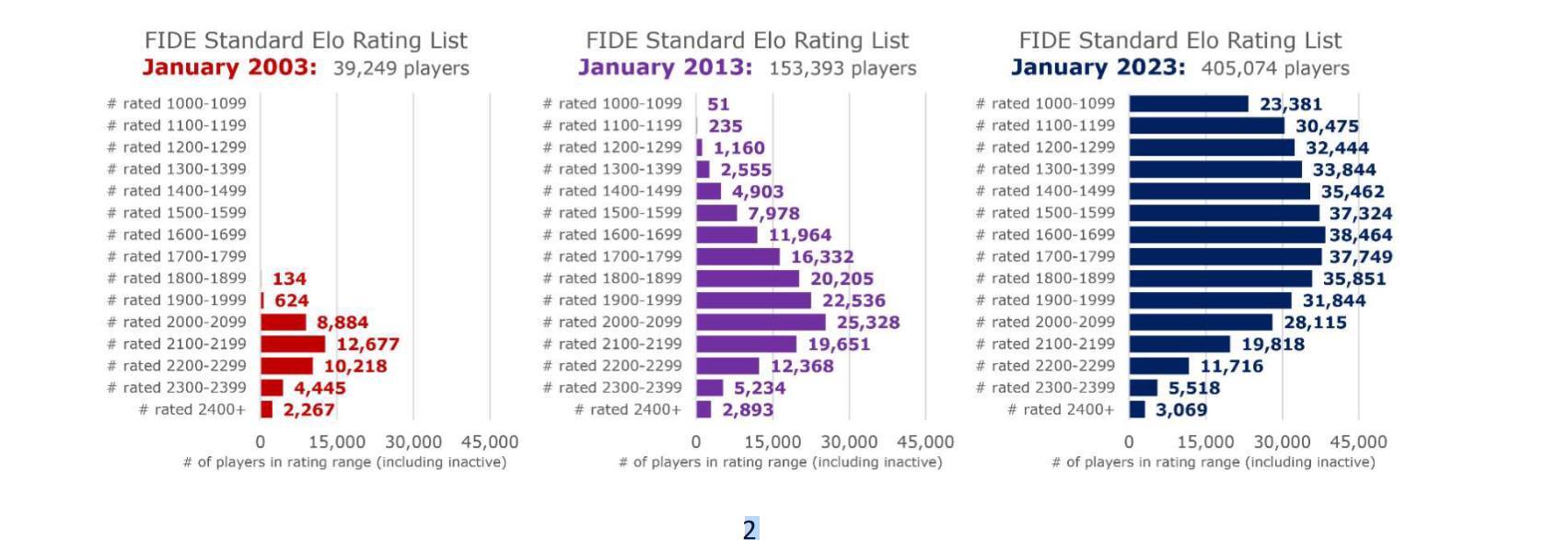
FIDE Set To Make Significant Changes To Rating System In January
FIDE is expected to make significant changes to its rating system on January 1, which includes a one-time adjustment for most rated players, an increase of the rating floor, and changes to the initial rating.
In July, the FIDE Qualifications Commission (QC) opened a public discussion in order to improve the accuracy of the rating system and combat deflation.
After receiving more than 150 comments from the public, the working group, consisting of GM Aleksander Moiseenko, GM Pavel Tregubov, Nick Faulks, Vladimir Kukaev, and Sabrina de San Vincente, together with statistician Jeff Sonas, announced the conclusions of the discussions this week.
Four changes to the rating system have been recommended by the group. These changes will take effect on January 1, 2024, if approved by the FIDE Council on December 14:
- One-Time Adjustment To Classical Ratings
- Adjustment of the Rating Floor
- Changes in the initial rating
- Reinstallment of the 400-point rule
Rating Increase Of Up To 400 points
The adjustment for players rated below 2000 will affect 85% of rated players who will see their rating increase with the following formula:
(0.40) x (2000 - Rating)
The formula means players will have somewhere between 0 and 400 Elo points added to their ratings. Players rated at exactly 1000, would get an increase of 400 points, while a player rated 1500 would increase the rating by 200 points. A player rated at 1950 will only get 20 points added.
Sonas explained that the goal is to compress the ratings from 1400-2000 without affecting the order of the players, only the spacing between them.
“There would be the same 346,000 players rated below 2000 Elo both before and after; it's just that they would now span a range of 600 Elo points rather than 1,000 Elo points," Sonas writes.
Increasing Rating Floor To 1400
Another major change is the adjustment of the minimum FIDE rating from 1000 to 1400. The graphic below shows how the distribution of rated players has changed across the last 20 years:

Sonas explained that the gradual reduction of the minimum rating to 1800 in 2001, then incrementally to 1600, 1400, 1200, and finally 1000 in August 2012, had a "very problematic side-effect":
Many younger/weaker players receive very low initial FIDE ratings now at a very young age, during the stage of their career when their chess skill is improving most rapidly, and this combination of low initial ratings and rapidly-improving players has ultimately produced a strong deflationary pressure upon the overall rating system for the past decade.
Sonas says that while the rating system experienced inflation 20-30 years ago with more and more players rated above 2700, the problem is now "rating deflation." The theory is that hundreds of thousands of new lower-rated players entered the system, and as they have competed, improved, and gained rating points, they have also taken them from established players, sparking an overall deflation.
Another point is how the COVID-19 shutdown, with the drastic reduction in events, made things worse for deflation, according to Sonas.
The lack of rated events did not keep all those weaker junior players from improving their chess skill, creeping ever closer toward the playing strength of master-level players. But the shutdown did severely restrict the ability of the Elo rating system to keep pace with the advancement of all those weaker junior players. Because of this, it seems quite plausible that a 1500 Elo rating today, for example, reflects a closer proximity to master-level skill than a 1500
Calculation Improvements
The other proposed changes, are called "Calculation Improvements." The 400-Points Rule will be reinstated to the pre-2022 state, with no restrictions on how many times it can be applied to a player during a single tournament.
FIDE noted that 90% of the feedback from the public wanted to reverse the rule.
There will also be changes to the initial rating. Unrated players achieving a plus score against rated opponents will have their initial rating calculated based on the performance rating derived from their percentage score, with the maximum not exceeding 2200.
Whether this will have the intended effect, remains to be seen, but Sonas seems confident and concludes in the end:
There is every reason to expect that these measures will be very effective at reversing the effects of a decade or more of rating deflation, as well as providing strong counter-measures to prevent it from happening again. This will lead to a FIDE Standard Elo rating system that will be functioning far better than is currently the case.
The recommendations are intended to apply to all formats: classical, rapid, and blitz.

